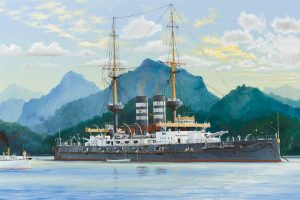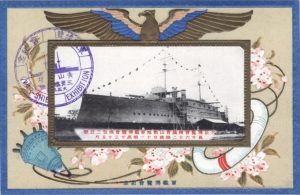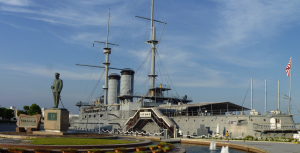- Author
- A.N. Other
- Subjects
- Ship histories and stories, History - WW2
- Tags
-
- RAN Ships
- None noted.
- Publication
- September 2019 edition of the Naval Historical Review (all rights reserved)
By Colin Randall
After many years of visiting Japan for coal business I took my family on a holiday to this interesting country. One of the sites visited was the battleship Mikasa, just outside the US Navy Base at Yokosuka on Tokyo Bay. My reason for visiting was that Mikasa was the only pre-Dreadnought battleship still left in the world and that my grandfather, in the Royal Navy from 1906 until 1946, had in his early days served on a pre-Dreadnought. I wanted to experience what it was like for my grandfather to be on such a ship with such a large crew, required to keep her coal fired boilers operating.
Mikasa was built in Great Britain and commissioned into the newly formed Imperial Japanese Navy (IJN) in 1902. She was the Japanese flagship at the Battle of Tsushima in May 1905 when the Japanese navy overwhelmed a Russian fleet in the first victory of an Asian navy over a Western force. After destroying two-thirds of the enemy ships, Admiral Togo accepted the surrender of the Russian fleet.
Mikasa had been hit many times but survived with relatively light casualties. However, a few days after the battle, she sank as a result of a fire and explosion that killed some 250 of her crew. She was raised the following year and went on to fight in WWI and afterwards in operations against Soviet Russia.
Mikasa was decommissioned on 23 September 1923 following the Washington Naval Treaty and was scheduled for destruction. However, at the request of the Japanese government, each of the signatory countries to the treaty agreed that Mikasa could be preserved as a memorial ship with her hull encased in concrete. The engines were removed and the guns made unserviceable. On 12 November 1926, Mikasa was opened for display in Yokosuka in the presence of the then Crown Prince, Prince Hirohito, and retired Admiral Togo. Mikasa became a place of pilgrimage and national homage to the memory of Admiral Togo and the victory over Russia.

During WWII Mikasa was bombed during air raids. After the surrender of the Japanese in Tokyo Bay in September 1945 the US Navy took over the Yokosuka Navy Base. During my visit to Mikasa I heard from a Japanese colleague the story of the ship’s restoration, which went like this:
When the Americans came in 1945 they ordered Mikasa’ssuperstructure to be cut up and for a Quonset hut to be put on the deck to provide a recreation hall for US Navy men. The steel superstructure was to be sold as scrap and melted down. Some 20 years later the then US Commander of the Yokosuka Naval Base spoke to the Mayor of Yokosuka about re-creating the superstructure of Mikasa and once again turning it into a museum. This gesture was one of reconciliation.
The Commander had obtained from Great Britain the original drawings of the ship and they would manufacture superstructure similar to the original.
The Mayor said ‘There is no need!’
The Commander said again they wanted to do it as a symbol of reconciliation.
The Mayor said again ‘There is no need!’
The Commander finally asked ‘Why do you say that?’
The answer: ‘We have all the original superstructure that was removed. We have held it secretly in storage. It was not melted down. We can have it simply put back in place’!
So that was the simple explanation for the remarkable restoration of Mikasa. However, in preparing to write this short article I decided to research as much as I could this remarkable story of restoration. However, as with all research start with the ABC of:
- Assume nothing.
- Believe no one.
- Check everything.


Post-war fate of Mikasa
The land-locked Mikasa had been a favourite target during air raids and was repeatedly bombed. Upon the US Navy taking over Yokosuka base, US Navy Admiral Chester Nimitz personally inspected Mikasa and ordered a guard on her to stop souveniring. The Russians however demanded the complete destruction of Mikasa. But upon the Russian Ambassador visiting the ship he saw that it was already destroyed by the air raids. However, the guns were dismantled and removed as was the superstructure. The US took delivery and stored parts of the superstructure. Weeds grew around Mikasa over the next five years when most Japanese were more concerned about food than preserving heritage.
In 1950, war in Korea made Yokosuka come alive in a way it had not been since the surrender. The American Fleet was back in a big way, and the port was the logical support base for operations; there was a crush of sailors enjoying the pleasures of the harbour.
Mikasa was only a brisk walk or a short rickshaw ride from the base for those flush with cash, hauled along by wiry ex-Imperial soldiers down on their luck. To capitalise on the situation, the enterprising Japanese business community came up with a use for the gutted hull.
A large barn-like structure was built on the main deck, and the pride of the Tsushima Strait became the Club Mikasa, a dance hall and nightclub for American sailors.It was remembered by some as ‘Café Togo’, a cheap boozer/dive providing female entertainment to US servicemen. Club Mikasa failed and the operation of an aquarium failed too. The ship was abandoned yet again. However, in 1955 a Briton (now residing in the USA) named John S. Rubin visited the ship and later wrote a letter to the Japan Times expressing his shock at its state of disrepair which by then had been used for a time as a dance hall.
Rubin’s letter appeared in the Japan Times on 24 September 1955: ‘I saw the Mikasa launched and completed at Vickers Sons and Maxim’s Shipbuilding Works at Barrow-in-Furness, England,’ he wrote, explaining that the ship was built there between 1900 and 1902. Rubin goes on to note that during his visit to Japan he saw the old ship: The outer surface is fairly presentable, but the interior is a shambles and ghostlike in its decrepitude. This letter garnered wide public response and reaction around Japan and helped gather momentum to restore the ship.
In 1958 some thought had been given to the complete scrapping of the remains of Mikasa and this appeared to be the spur for some Japanese ex-military and persons interested in history to start a preservation movement. Also in 1958 American Admiral Chester Nimitz was contacted by the preservation committee to help with finances and to use his name to help the movement. Admiral Chester W. Nimitz had admired Togo since his days as a midshipman and had never forgotten his brief, cordial meeting with the admiral at a Tokyo garden party in the summer of 1905. In 1934 Nimitz represented the US Navy at the admirals’ funeral.

Consequently, soon after arriving in Yokosuka in 1945, Nimitz paid a visit to Mikasa and ordered a guard on board to prevent looting.
Nimitz saw the importance of the project and, with United States participation (including financial help) along with the Japan Times, collected money for the restoration of Mikasa. Admiral Nimitz had contributed to a collection of essays on restoring the battleship. He contributed his fee for the articles as the first donation to the restoration fund.
In 1958 the English-built Chilean Navy Super-Dreadnought Battleship Almirante Latorre was being scrapped in Japan. This ship provided a majority of the parts for the restoration of Mikasa’s superstructure. Earlier in 1957 the Argentinian battleship Moreno had been towed to Japan for scrapping and there were reports that parts of that ship could also have been used.
Meanwhile the US returned the parts of the ship that it had held in storage since 1945. With the potential three sources of materiel the superstructure of Mikasa was reconstructed. The question of the guns seems to have been answered by a volunteer at the Mikasa Museum who said they were replicas. The restoration of Mikasa cost 180 million yen. Ironically Misaka’s 12-inch forward gun turret now points directly at the US Navy Base.
The Cold War started and Mikasa, which could have been seen as a very potent symbol of Japanese militarism, was seen now as a potent symbol of national unity against the old enemy Russia which had now become the new enemy. Mikasawas opened to the public again on 27 May 1961, the 56th anniversary of the Battle of Tsushima Straits following a ceremony attended by all involved parties including His Imperial Highness Prince Masahito Yoshi, representing the Emperor.




